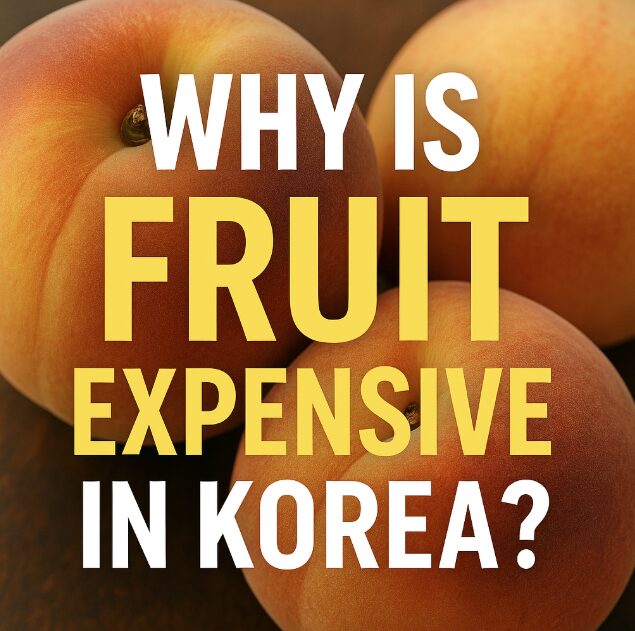If you’ve ever visited South Korea — even just for a short trip — you may have experienced a small moment of sticker shock while browsing the fruit section of a grocery store. Maybe it was a single apple priced at over $2, or a neatly wrapped box of pears costing more than $60. Compared to many Western countries, fruit in Korea often feels surprisingly expensive — especially when sold in gift boxes or at department stores.
But is it just a matter of packaging and presentation? Or is there more going on behind the scenes?
In this post, we’ll explore why fruit is expensive in Korea, the cultural values that drive the pricing, the agricultural limitations involved, and whether there are ways to enjoy fresh produce without breaking the bank. If you’re a traveler, student, or long-term resident in Korea, this guide will help you understand the fruit economy — and make smarter decisions the next time you’re craving a peach or a melon.

The Cultural Reason: Fruit as a Premium Gift
In Korean culture, fruit is not just food — it’s a symbol of respect, generosity, and care. High-end fruits are often used as holiday gifts, especially during Chuseok (Korean Thanksgiving) and Seollal (Lunar New Year).
During these seasons, it’s common to see:
Boxes of perfectly round apples and pears, individually wrapped in foam netting
Luxury packaging with gold ribbon or wooden boxes
Price tags ranging from 50,000 to 150,000 KRW (approx. $40 to $120 USD) per box
Why so expensive?
Aesthetics matter: Korean gift-giving culture prizes visual perfection. Bruised, misshapen, or dull-colored fruits are considered inappropriate as gifts.
Grading system: Fruits are graded and priced based on size, shape, and sweetness. Only the top-grade fruits make it into these premium gift sets.
Social signaling: Giving expensive fruit reflects thoughtfulness and status, especially when gifting to elders, teachers, or corporate clients.
This gift-giving practice means that growers and sellers often prioritize appearance and uniformity over quantity and affordability.
The Agricultural Reason: Land and Labor Constraints
Korea’s geography and agricultural structure also play a major role in the high cost of fruit.
Limited Arable Land
South Korea is 70% mountainous, which limits large-scale agricultural operations.
Fruit farms are typically small, family-owned plots, not industrial-scale plantations like those in the U.S., Chile, or Australia.
This limits yield and increases per-unit production cost.
Seasonal Dependence and Climate
Korea has distinct seasons, which means fruit harvests are limited to narrow time windows.
For example, strawberries are only available between January and April.
Many fruits are grown in greenhouses out of season, requiring additional energy and equipment, which raises costs.
Labor-Intensive Farming
Fruit cultivation in Korea is highly labor-intensive, often involving hand-picking, individual wrapping, and selective pruning
Labor costs are relatively high, and there’s limited use of migrant or seasonal labor compared to countries like the U.S.
As a result, each piece of fruit reflects a high input of time, care, and resources
The Market System: Distribution and Middlemen
Another contributing factor is Korea’s complex supply chain for agricultural goods.
Most fruits pass through multiple hands — from farmers to local distributors to wholesale markets to retail outlets
Each stage adds a markup
Department stores and premium grocery chains further inflate prices with luxury packaging and branding
Additionally, imported fruit is subject to tariffs, especially from countries that don’t have free trade agreements with Korea. While some fruits like bananas are relatively affordable due to long-established supply chains, others (like avocados, cherries, or tropical fruits) remain expensive.
Specific Examples of Expensive Fruits in Korea
Korean Pears (배)
Often sold in gift boxes with 6–10 fruits costing over $50
Larger, juicier, and crisper than Western pears
Grown mainly in Gyeonggi-do, Chungcheong-do, and Jeolla-do
Shine Muscat Grapes (샤인머스캣)
A luxury grape variety with high sugar content and thin skin
Often sold for 20,000–30,000 KRW per small bunch
Became a status symbol among young Koreans, especially on Instagram
Jeju Hallabong and Cheonhaehyang Citrus
Premium citrus varieties grown on Jeju Island
Hallabong is large, seedless, and extremely sweet
Cheonhaehyang is considered a “perfumed citrus” with floral aroma and high sugar
Prices range from 30,000–80,000 KRW per box
Melons (especially Korean Crown Melon)
Known for their perfect round shape and high sweetness
Often sold individually for 10,000 KRW or more
Crown melons are especially expensive due to selective breeding and care
How to Enjoy Korean Fruit Without Overspending
Even though fruit can be expensive, there are ways to enjoy it affordably:
Visit traditional markets (재래시장) like Gwangjang, Mangwon, or Namdaemun
These markets often have lower prices than supermarkets or department storesBuy in season: Fruits are cheapest and freshest at the peak of their harvest
Shop late in the day: Vendors often discount unsold produce in the evening
Buy “imperfect” fruit: Some markets sell off-grade or bruised fruit at a significant discount
Join local grocery apps: Apps like Market Kurly or Coupang Eats often run fruit sales and seasonal promotions
Also, if you’re in Korea short-term, try fruit cafés and dessert shops that specialize in seasonal produce. Strawberry bingsu in spring or melon parfaits in summer let you experience high-quality fruit without buying in bulk.
Korean Fruit Is Expensive — But for Cultural and Practical Reasons
When you see a Korean pear costing $8 or a grape box priced like a bottle of wine, it might seem excessive. But behind the price tag lies a combination of cultural tradition, agricultural limitations, and a deep-rooted appreciation for quality and aesthetics.
Fruit in Korea is not just food — it’s gift, symbol, and experience. It reflects the country’s values of care, perfection, and hospitality. And while it may cost more, it also delivers more — in flavor, freshness, and thoughtfulness.
For travelers and expats, understanding this context can make Korean fruit feel less like a luxury and more like a window into the country’s identity. So go ahead — splurge on that perfectly shaped pear once in a while. It’s not just a snack. It’s a taste of Korea’s cultural DNA.